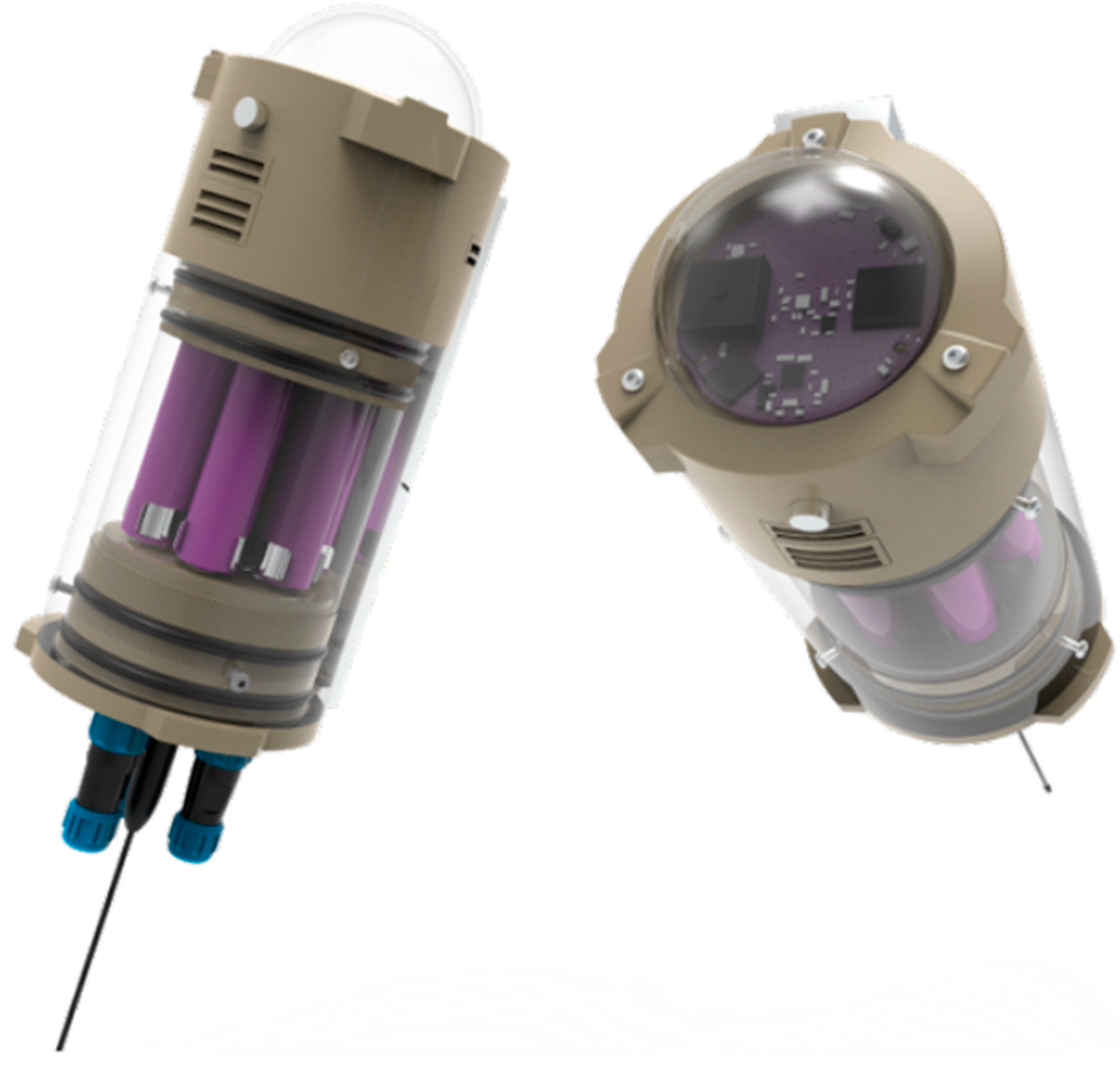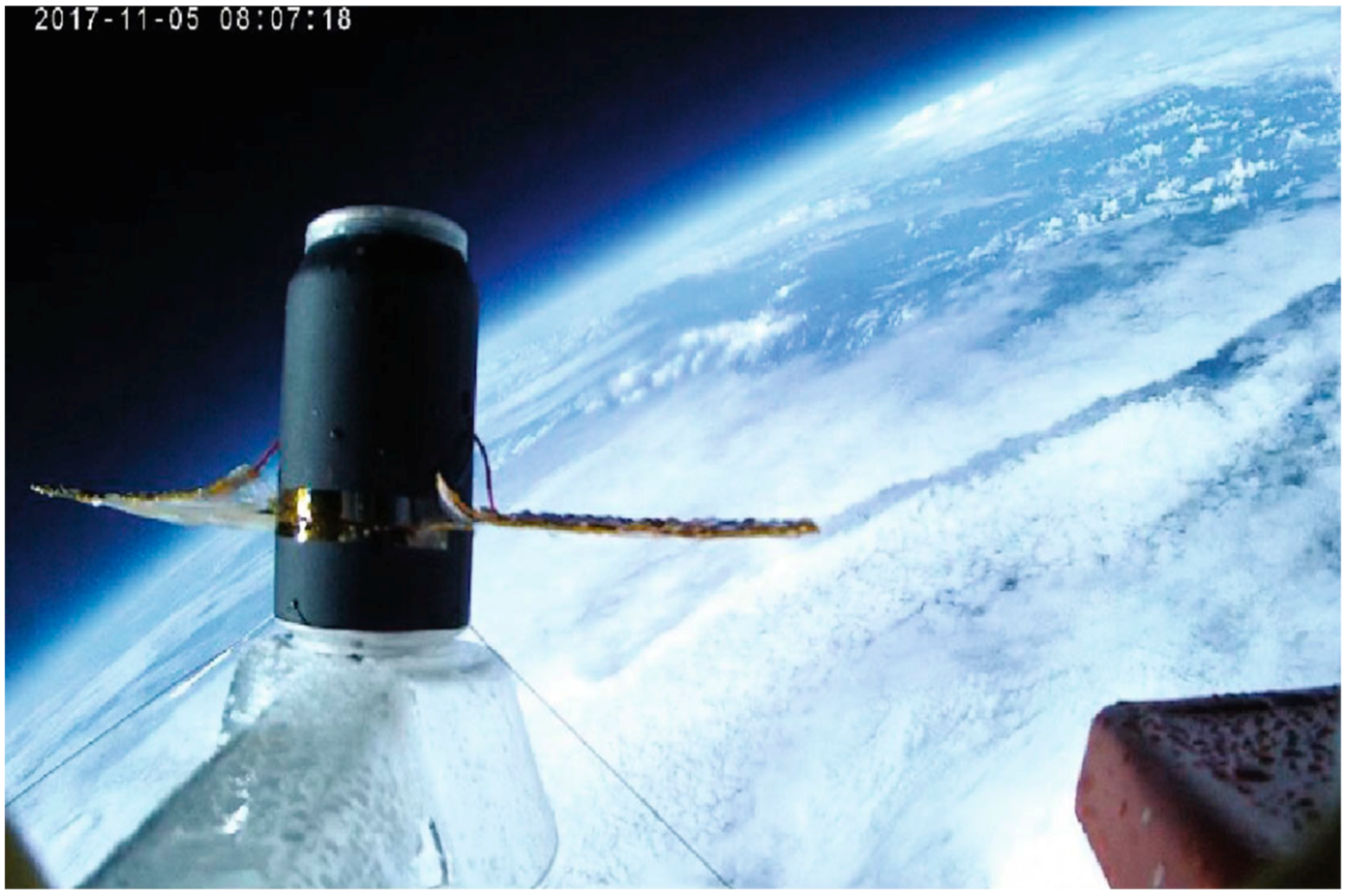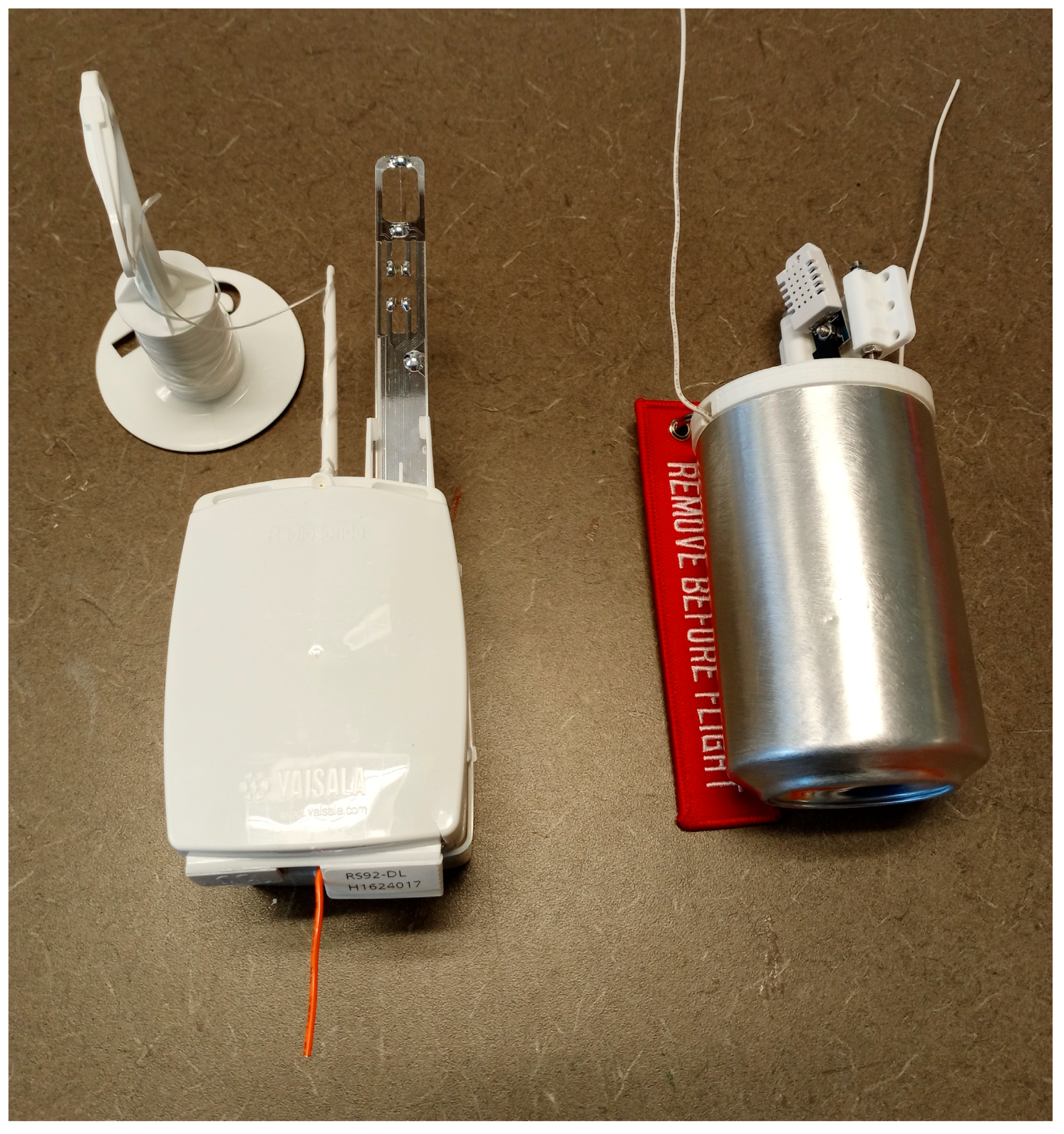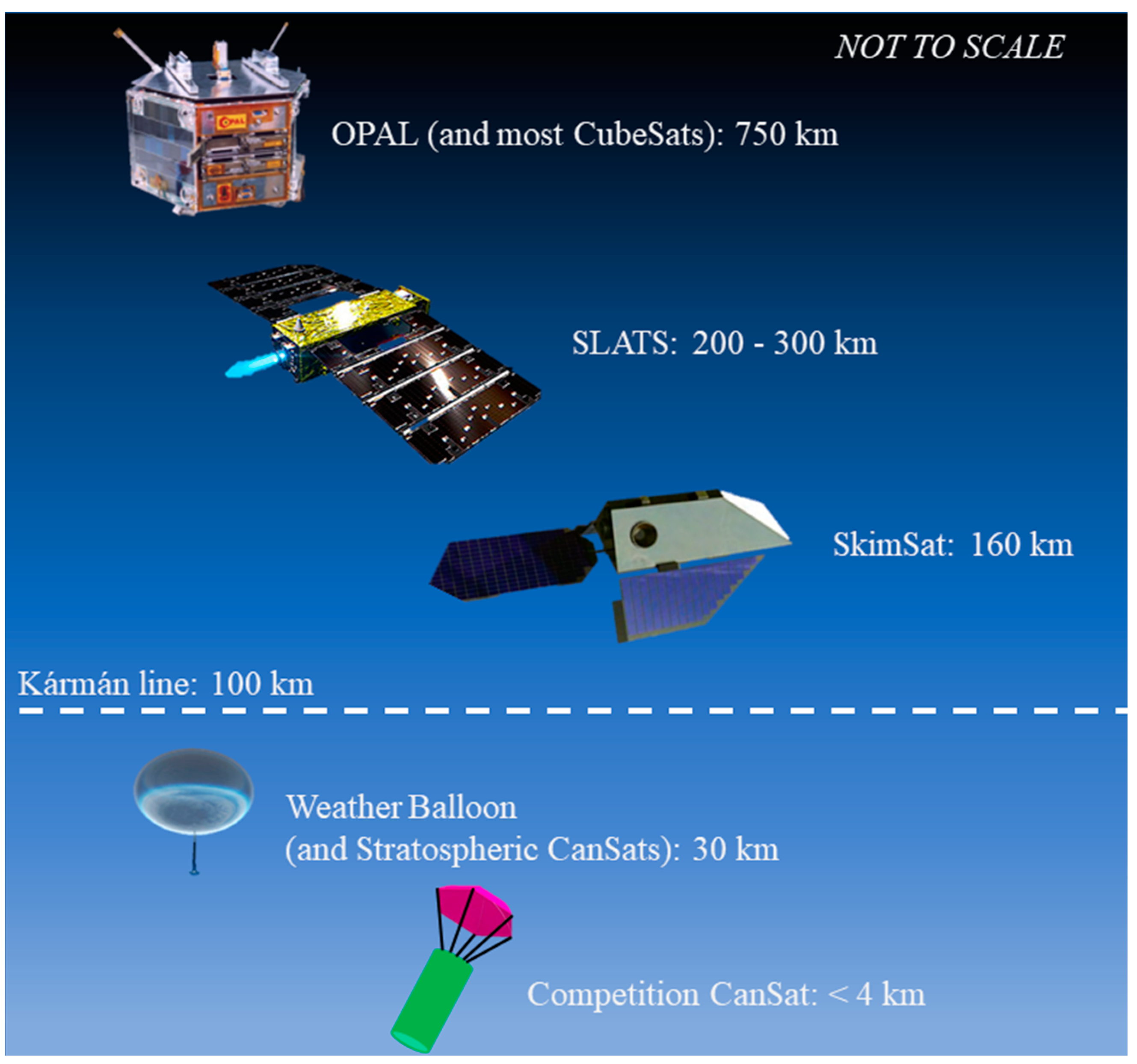The CanSat Compendium: A Review of Scientific CanSats
Abstract
:1. Introduction
2. History
3. CanSats in Application
3.1. Education
3.2. Earth and Atmospheric Studies
3.3. Aeronautic
3.4. Data Handling and Wireless Transmision
3.5. General Hardware and Software Testing
4. Definition
4.1. CanSats Are Not Radiosondes
4.2. CanSats Are Not CubeSats
4.3. Developing a Technical Definition
5. Future Directions
6. Conclusions
Author Contributions
Funding
Data Availability Statement
Acknowledgments
Conflicts of Interest
References
- Cappelletti, C.; Battistini, S.; Malphrus, B.K. (Eds.) CubeSat Handbook: From Mission Design to Operations; Academic Press is an imprint of Elsevier: London, UK; San Diego, CA, USA, 2021; ISBN 978-0-12-817884-3. [Google Scholar]
- Soyer, S. Small space can: CanSat. In Proceedings of the 5th International Conference on Recent Advances in Space Technologies—RAST2011, Istanbul, Turkey, 9 June 2011; pp. 789–793. [Google Scholar]
- Twiggs, R. Space engineering—Project based learning by working real space programs. In Proceedings of the American Society of Engineering Educators Annual Conference, American Society of Engineering Educators, Montreal, QC, Canada, 16 June 2002; p. 10. [Google Scholar]
- Colin, A. A Pico-Satellite Assembled and Tested during the 6th CanSat Leader Training Program. J. Appl. Res. Technol. 2017, 15, 83–91. [Google Scholar] [CrossRef] [Green Version]
- Sako, N.; Tsuda, Y.; Ota, S.; Eishima, T.; Yamamoto, T.; Ikeda, I.; Ii, H.; Yamamoto, H.; Tanaka, H.; Tanaka, A.; et al. Cansat suborbital launch experiment—University educational space program using can sized pico-satellite. Acta Astronaut. 2001, 48, 767–776. [Google Scholar] [CrossRef]
- Khali, M.; Miyazaki, Y. (Eds.) CanSat Pico Size Artificial Satellite, 4th ed.; University Space Engineering Consortium: St. Gallen, Switzerland, 2017. [Google Scholar]
- U.S. Naval Research Laboratory. What Is CanSat? U.S. Naval Research Laboratory: Washington, DC, USA, 2011. [Google Scholar]
- American Astronautical Society. CanSat Competition Guide 2023; American Astronautical Society: Springfield, VA, USA, 2022. [Google Scholar]
- Walker, R.; Galeone, P.; Page, H.; Castro, A.; Emma, F.; Callens, N.; Ventura-Traveset, J. ESA Hands-on space education project activities for university students: Attracting and training the next generation of space engineers. In Proceedings of the IEEE EDUCON 2010 Conference, Madrid, Spain, 14 April 2010; pp. 1699–1708. [Google Scholar]
- European Space Agency. CANSAT: 2022–2023 Guidelines; European Space Agency: Paris, France, 2023. [Google Scholar]
- Chancharoen, W.; Witoon, S.; Pataranutaporn, P.; Ngamarunchot, B.; Theanthong, P. The national cansat competition: Lessons, challenges and outcomes of the first cansat competition in thailand. In Proceedings of the 69th International Astronautical Congress (IAC), Bremen, Germany, 1–5 October 2018. [Google Scholar] [CrossRef]
- Hasan Raian, F.M.T.; Islam, H.M.J.; Islam, M.S.; Azam, R.; Islam, H.M.J.; Debnath, S. An Affordable CanSat Design and Implimentation to Study Space Science for Bangladeshi Students. In Proceedings of the 2020 IEEE Region 10 Symposium (TENSYMP), Dhaka, Bangladesh, 5 June 2020; pp. 1205–1208. [Google Scholar]
- Aly, H.; Sharkawy, O.; Nabil, A.; Yassin, A.; Tarek, M.; Amin, S.M.; Ibrahim, M.K. Project-based space engineering education: Application to autonomous rover-back CanSat. In Proceedings of the 2013 6th International Conference on Recent Advances in Space Technologies (RAST), Istanbul, Turkey, 12 June 2013; pp. 1087–1092. [Google Scholar]
- Contente, J.; Galvão, C. STEM Education and Problem-Solving in Space Science: A Case Study with CanSat. Educ. Sci. 2022, 12, 251. [Google Scholar] [CrossRef]
- Ramadhan, R.P.; Ramadhan, A.R.; Putri, S.A.; Latukolan, M.I.C.; Kusmadi, E. Prototype of CanSat with auto-gyro payload for small satellite education. In Proceedings of the 2019 IEEE 13th International Conference on Telecommunication Systems, Services and Applications (TSSA), Bali, Indonesia, 3 October 2019; pp. 243–248. [Google Scholar]
- Ames-Lizarbe, J.A.; Bala-Romero, B.L.; Cortez-Reategui, R.E.; Espillco-Luicho, M.A.; Leon-Nunez, R.F.; Solis-Alvites, S.G.; Roman-Gonzalez, A. INCAnSat: CanSat for Education and Environmental Monitoring. IEEE Aerosp. Electron. Syst. Mag. 2021, 36, 43–50. [Google Scholar] [CrossRef]
- Eerkens, R.; Van Breukelen, E.; Verhoeven, C.; Vollebregt, S.; Fitié, A. The dutch cansat competition: How 350 secondary school pupils compete to build the most innovatibe “satellite” in a soda can. In Proceedings of the 59th International Astronautical Congress: IAC 2008, IAF, Glasgow, Scotland, 29 September–3 October 2008; pp. 1–8. [Google Scholar]
- Ghazanfarinia, S.; Jazebizadeh, H.; Simard, M.; Bakhtiari Mojaz, S.; Ahmadi, G. ARIC-2: Lightest Atmospheric Sounding Cansat; Aerospace Research Institute: Tehran, Iran, 2011. [Google Scholar]
- Islam, T.; Noureen, A.; Mughal, M.R.; Nadeem, M.A. Design and development of a weather monitoring satellite, CanSat. In Proceedings of the 2019 15th International Conference on Emerging Technologies (ICET), Peshawar, Pakistan, 2 December 2019; pp. 1–6. [Google Scholar]
- Yarce Botero, A.; Lopez Restrepo, S.; Sebastian Rodriguez, J.; Valle, D.; Galvez-Serna, J.; Montilla, E.; Botero, F.; Henzing, B.; Segers, A.; Heemink, A.; et al. Design and Implementation of a Low-Cost Air Quality Network for the Aburra Valley Surrounding Mountains. Pollutants 2023, 3, 150–165. [Google Scholar] [CrossRef]
- Chodkaveekityada, P. CanSat design and their applications. In Proceedings of the 2018 SpaceOps Conference, Marseille, France, 28 May 2018; American Institute of Aeronautics and Astronautics: Reston, VA, USA, 2018. [Google Scholar]
- Gopal, G.; Harith, B.; Ritwik, R.; Savyasachi, J.; Chetan, U. Weather Monitoring Using Parachute Satellite-CanSat. Int. J. Eng. Sci. Comput. 2016, 6, 5181–5184. [Google Scholar] [CrossRef]
- Hasan, M.; Rahman, I.I.; Hossam-E-Haider, M.; Shah Sadman, A.A.M. Design of CanSat for environmental monitoring and object detection. In Proceedings of the 2021 5th International Conference on Electrical Engineering and Information Communication Technology (ICEEICT), Dhaka, Bangladesh, 18 November 2021; pp. 1–6. [Google Scholar]
- Faroukh, Y.M.; Mohamed Abdelkarim AL-Ali, A.A.; Adwan, A.O.; Alhammadi, A.; Shaikh, M.M.; Faroukh, A.M.; Femini, I. Environmental monitoring using CanSat. In Proceedings of the 2019 6th International Conference on Space Science and Communication (IconSpace), Johor Bahru, Malaysia, 28 July 2019; pp. 239–244. [Google Scholar]
- Bhad, B.; Akant, K. Experimental cansat for measurment of UV radiation. In Proceedings of the 2019 9th International Conference on Emerging Trends in Engineering and Technology—Signal and Information Processing (ICETET-SIP-19), Nagpur, India, 1 November 2019; pp. 1–4. [Google Scholar]
- Colin, A.; Jimenez-Lizárraga, M. The CanSat technology for climate monitoring in small regions at altitudes below 1 km. In Proceedings of the Designing Solutions: Concepts, Enabling Technologies and Operational Constraints, Mexico City, Mexico; Available online: Researchgate.net (accessed on 1 June 2023).
- American Astronautical Society. CanSat Competition Guide 2019; American Astronautical Society: Springfield, VA, USA, 2018. [Google Scholar]
- American Astronautical Society. CanSat Competition Guide 2022; American Astronautical Society: Springfield, VA, USA, 2021. [Google Scholar]
- Ventura, A.; Nuñez-Quispe, J.; Sanchez, G.; Santivañez, J. CanSat Payload with Autogyro for Descent in Experimental Rocket Flights: Development, CFD Analysis and Preliminary Test on Free-Fall. J. Phys. Conf. Ser. 2022, 2235, 012055. [Google Scholar] [CrossRef]
- Shukla, P.; Mishra, R.; Sardar, U.A.; Mohapatra, B. Satellite design for CANSAT with autorotatig payloads. In Proceedings of the 2022 4th International Conference on Advances in Computing, Communication Control and Networking (ICAC3N), Greater Noida, India, 16 December 2022; pp. 2385–2392. [Google Scholar]
- American Astronautical Society. CanSat Competition Guide 2017; American Astronautical Society: Springfield, VA, USA, 2016. [Google Scholar]
- American Astronautical Society. CanSat Competition Guide 2020; American Astronautical Society: Springfield, VA, USA, 2019. [Google Scholar]
- Aliyev, I.; Misirli, C.A.; Ozturk, S.; Mahmurat, E.; Erkek, A.; Kok, S.; Kocyigit, D.; Uzun, S.; Vural, R.A. Design of solar powered subscale glider for CanSat competition. In Proceedings of the 2017 8th International Conference on Recent Advances in Space Technologies (RAST), Istanbul, Turkey, 19 June 2017; pp. 453–457. [Google Scholar]
- Kizilkaya, M.O.; Oguz, A.E.; Soyer, S. CanSat descent control system design and implementation. In Proceedings of the 2017 8th International Conference on Recent Advances in Space Technologies (RAST), Istanbul, Turkey, 19 June 2017; pp. 241–245. [Google Scholar]
- Pradhan, E.; Dadheech, A.; Agarwal, H.; Singh, T.; Singari, R.M. India Design Concept of a Model Can-Sized Sub-Orbital Satellite. J. Eng. Res. 2021, 79, 88. [Google Scholar] [CrossRef]
- Songul, G.; Yalman, A.; Ilginoglu, A.; Gokce, A.; Koculu, O.E.C.; Kirli, A.; Koru, A.T.; Tufekci, C.S. Model picosatellite design for energy harvesting and telemetry data transmission through RF communication. In Proceedings of the 2015 7th International Conference on Recent Advances in Space Technologies (RAST), Istanbul, Turkey, 16 June 2015; pp. 839–844. [Google Scholar]
- Cheong, J.W.; Southwell, B.J.; Andrew, W.; Aboutanios, E.; Lam, C.; Croston, T.; Li, L.; Green, S.; Kroh, A.; Glennon, E.P.; et al. A Robust Framework for Low-Cost Cubesat Scientific Missions: In-Orbit Recovery, Results and Lessons Learned from UNSW-EC0. Space Sci. Rev. 2020, 216, 8. [Google Scholar] [CrossRef]
- Chua, H.C.; Jay Flores, C.; Padilla, A.G.; Dale Ambatali, C. Design and implementation of a low cost amateur radio unit for cube satellites. In Proceedings of the 2019 IEEE Asia-Pacific Conference on Applied Electromagnetics (APACE), Melacca, Malaysia, 25 November 2019; pp. 1–6. [Google Scholar]
- Salvatus, J.; Constante, M.A.; Violan, E.P.; Salces, A.; Paet, L.B.; Talampas, M.C.; Marciano, J.S. Development of deployable antennas for the diwata-2 microsatellite’s amateur radio payload. In Proceedings of the 2017 IEEE International Conference on Communication, Networks and Satellite (Comnetsat), Semarang, Indonesia, 5 October 2017; pp. 26–31. [Google Scholar]
- Rodríguez, J.S.; Botero, A.Y.; Valle, D.; Serna, J.G.-; Botero, F. Experimental Approach for the Evaluation of the Performance of a Satellite Module in the CanSat Form Factor for In Situ Monitoring and Remote Sensing Applications. Int. J. Aerosp. Eng. 2021, 2021, 1–28. [Google Scholar] [CrossRef]
- Aydemir, M.E.; Dursun, R.C.; Pehlevan, M. Ground station design procedures for CANSAT. In Proceedings of the 2013 6th International Conference on Recent Advances in Space Technologies (RAST), Istanbul, Turkey, 12 June 2013; pp. 909–912. [Google Scholar]
- Ehikhamenle, M.; Omijeh, B.O. Design and Implementation of CanSat (A Pico–Satellite). Int. J. Sci. Eng. Investig. 2017, 6, 106–111. [Google Scholar]
- Sreenivasaraja, N.; Raj, J.J.J.; Nandhagobalan, B.; Kavin, S. Design and Fabrication of Advance Level CANSAT Used for Measuring the Atmospheric Parameters and GPS Tracking System. Int. J. Sci. Adv. Res. Technol. 2018, 4, 1264–1269. [Google Scholar]
- Joseph Nunez-Quispe, J. Design and simulation of a rover cansat non-pneumatic wheel: Preliminary study for a certain test obstacle path. In Proceedings of the 2021 12th International Conference on Mechanical and Aerospace Engineering (ICMAE), Athens, Greece, 16 July 2021; pp. 484–488. [Google Scholar]
- Akiyama, M.; Ninomiya, H.; Saito, T. Method to Achieve High Speed and High Recognition Rate of Goal from Long Distance for CanSat. J. Robot. Mechatron. 2023, 35, 194–205. [Google Scholar] [CrossRef]
- Celebi, M.; Ay, S.; Ibrahim, M.K.; Aydemir, M.E.; Bensaada, M.; Fernando, L.; Akiyama, H.; Yamaura, S. Design and navigation control of an advanced level CANSAT. In Proceedings of the 5th International Conference on Recent Advances in Space Technologies—RAST2011, Istanbul, Turkey, 9 June 2011; pp. 752–757. [Google Scholar]
- Aydemir, M.E.; Celebi, M.; Ay, S.; Vivas, E.V.; Calle Bustinza, F.; Phan, D. Design and implementation of a rover-back CANSAT. In Proceedings of the 5th International Conference on Recent Advances in Space Technologies—RAST2011, Istanbul, Turkey, 9 June 2011; pp. 800–803. [Google Scholar]
- Umit, M.E.; Cabanas, W.; Tetlow, M.; Akiyama, H.; Yamaura, S.; Olaleye, S. Development of a fly-back CANSAT in 3 weeks. In Proceedings of the 5th International Conference on Recent Advances in Space Technologies—RAST2011, Istanbul, Turkey, 9 June 2011; pp. 804–807. [Google Scholar]
- Ostaszewski, M.; Dzierzek, K.; Magnuszewski, L. Analysis of data collected while CanSat mission. In Proceedings of the 2018 19th International Carpathian Control Conference (ICCC), Szilvasvarad, Hungary, 28 May 2018; pp. 1–4. [Google Scholar]
- Abo-Arais, M.; Elfeki, M.; Mohammed, A.; El-Mohr, M.; Abdelmoteleb, B.; Hatem, A.; Mohamed, A.-B.; Ramy, A.; Walid, K.; El-Fiky, M.; et al. Approaching a nano-satellite using CAN-SAT systems. In Proceedings of the 2015 7th International Conference on Recent Advances in Space Technologies (RAST), Istanbul, Turkey, 16 June 2015; pp. 813–817. [Google Scholar]
- Svensson, A. Atmospheric Measurement Using CanSat; Mid Sweden University: Östersund, Sweden, 2020; p. 43. [Google Scholar]
- Soltani, M.M.; Khanmirza, E.; Mohammadi, E.; Navid, N.S.H. A new framework for design and development imaginary CanSat. In Proceedings of the 14th International Conference of Iranian Aerospace Society, Tehran, Iran, 25–27 March 2015; Iranian Research Organization for Science and Technology: Tehran, Iran, 2015. [Google Scholar]
- Radiosonde RS41-SG 2017; Vaisala: Vantaa, Finland, 2017.
- Radiosonde RS41-D 2017; Vaisala: Vantaa, Finland, 2017.
- Radiosonde RS41-SGP 2020; Vaisala: Vantaa, Finland, 2020.
- Gemignani, M.; Marcuccio, S. Dynamic Characterization of a High-Altitude Balloon during a Flight Campaign for the Detection of ISM Radio Background in the Stratosphere. Aerospace 2021, 8, 21. [Google Scholar] [CrossRef]
- Baynton, H.W. AN/AMQ-15 Rocketsonde Tests at White Sands Proving Ground. Bull. Am. Meteorol. Soc. 1961, 42, 34–41. [Google Scholar] [CrossRef] [Green Version]
- Lafon, T.; Fowler, J.; Jiménez, J.F.; Cordoba, G.J.T. A Viable Alternative for Conducting Cost-Effective Daily Atmospheric Soundings in Developing Countries. Bull. Am. Meteorol. Soc. 2014, 95, 837–842. [Google Scholar] [CrossRef] [Green Version]
- Kräuchi, A.; Philipona, R. Return Glider Radiosonde for in Situ Upper-Air Research Measurements. Atmospheric Meas. Tech. 2016, 9, 2535–2544. [Google Scholar] [CrossRef] [Green Version]
- Bulut, S.N.; Gul, M.; Beker, C.; Ipek, I.I.; Koculu, O.E.C.; Topaloglu, C.; Dincer, N.; Kirli, A.; Ertugrul, H.F.; Tufekci, C.S. Model satellite design for CanSat competition. In Proceedings of the 2013 6th International Conference on Recent Advances in Space Technologies (RAST), Istanbul, Turkey, 12 June 2013; pp. 913–917. [Google Scholar]
- Ticona Coaquira, F.J.; Richard Diaz Palacios, F.; Vidaurre Torrez, K.W.; Ricardo Conchari Cabrera, C.; Valda Penaranda, J.D.; Alejandro Condori Machaca, J. Main analysis for the disturbance torques over the Altiplano region for 1U CubeSat Nadir earth pointing. In Proceedings of the 2022 IEEE Andescon, Barranquilla, Colombia, 16 November 2022; pp. 1–7. [Google Scholar]
- Hall, H.; Chamieh, M.; Chu, J.; Daruwala, R.; Duong, V.; Holt, S.; Jeong, D.; Lally, M.; Nguyen, L.; Rafizadeh, R.; et al. Utilizing high altitude balloons as a low-cost CubeSat test platform. In Proceedings of the 2020 IEEE Aerospace Conference, Big Sky, MT, USA, 7 March 2020; pp. 1–11. [Google Scholar]
- Carreno-Luengo, H.; Camps, A.; Querol, J.; Forte, G.; Onrubia, R.; Diez, R. A stratospheric balloon GNSS-R experiment: The 3Cat-2 project in DLR/SNSB BEXUS. In Proceedings of the 2014 IEEE Geoscience and Remote Sensing Symposium, Quebec City, QC, Canada, 13 July 2014; pp. 3626–3629. [Google Scholar]
- Pont, B.; Beurskens, J.; Dalderup, J.; Dolron, P.; Gubbels, J.; Hörandel, J.R.; Jordans, R.; Pourshaghaghi, H.; Szálas-Motesiczky, D.; Van Vliet, T.; et al. REXUS-25 rocket flight of a CubeSat cosmic-ray detector. In Proceedings of the 36th International Cosmic Ray Conference—PoS (ICRC2019), Madison, WI, USA, 22 July 2019; p. 124. [Google Scholar]
- Lovdahl, B. Software-Defined Radio Payload Design for Cubesat and X-Band Communications; Naval Postgraduate School: Monterey, CA, USA, 2018. [Google Scholar]
- González-Bárcena, D.; Peinado-Pérez, L.; Fernández-Soler, A.; Pérez-Muñoz, Á.G.; Álvarez-Romero, J.M.; Ayape, F.; Martín, J.; Bermejo-Ballesteros, J.; Porras-Hermoso, Á.L.; Alfonso-Corcuera, D.; et al. TASEC-Lab: A COTS-Based CubeSat-like University Experiment for Characterizing the Convective Heat Transfer in Stratospheric Balloon Missions. Acta Astronaut. 2022, 196, 244–258. [Google Scholar] [CrossRef]
- Lay, K.S.; Li, L.; Okutsu, M. High Altitude Balloon Testing of Arduino and Environmental Sensors for CubeSat Prototype. HardwareX 2022, 12, e00329. [Google Scholar] [CrossRef]
- Wijanto, H.; Syihabuddin, B.; Prasetyo, A.D.; Gautama, Y.; Khrisna, I.; Mardiansyah, G. A Preliminary design and testing of the On Board Data Handling (OBDH) for nano-satellite using an atmospheric balloon. In Proceedings of the 2015 1st International Conference on Wireless and Telematics (ICWT), Manado, Indonesia, 17 November 2015; pp. 1–6. [Google Scholar]
- Pawar, P.; Pawar, A.; Valvi, A.; Gite, R. Lower Atmosphere Research Satellite (LARS). Int. Res. J. Eng. Technol. 2017, 4, 2133–2138. [Google Scholar]
- Antunes, S. DIY Satellite Platforms; O’Reilly: Beijing, China; Sebastopol, Ukraine, 2012; ISBN 978-1-4493-1060-8. [Google Scholar]
- Llop, J.V.; Roberts, P.C.; Hao, Z.; Tomas, L.R.; Beauplet, V. Very Low Earth Orbit Mission Concepts for Earth Observation: Benefits and Challenges; Springer: London, UK, 2014. [Google Scholar]
- Kawasaki, H.; Konoue, K.; Hoshino, H.; Kaneko, Y.; Sasaki, M. Interim report of super low altitude satellite operation. In Proceedings of the IGARSS 2018—2018 IEEE International Geoscience and Remote Sensing Symposium, Valencia, Spain, 22 July 2018; pp. 4066–4069. [Google Scholar]
- Williamson, M. Aerospace America; AIAA: Reston, VA, USA, 2015; p. 9. [Google Scholar]
- Bacon, A.; Olivier, B. Skimsats: Bringing down the cost of earth observation. In Proceedings of the 12th Reinventing Space Conference, 2017; Hatton, S., Ed.; Springer International Publishing: Cham, Switzerland, 27 December 2016; pp. 1–7. ISBN 978-3-319-34023-4. [Google Scholar]
- Serrano, P.; Gramaglia, M.; Mancini, F.; Chiaraviglio, L.; Bianchi, G. Balloons in the Sky: Unveiling the Characteristics and Trade-Offs of the Google Loon Service. IEEE Trans. Mob. Comput. 2023, 22, 3165–3178. [Google Scholar] [CrossRef]






Disclaimer/Publisher’s Note: The statements, opinions and data contained in all publications are solely those of the individual author(s) and contributor(s) and not of MDPI and/or the editor(s). MDPI and/or the editor(s) disclaim responsibility for any injury to people or property resulting from any ideas, methods, instructions or products referred to in the content. |
© 2023 by the authors. Licensee MDPI, Basel, Switzerland. This article is an open access article distributed under the terms and conditions of the Creative Commons Attribution (CC BY) license (https://creativecommons.org/licenses/by/4.0/).
Share and Cite
Chun, C.; Tanveer, M.H.; Chakravarty, S. The CanSat Compendium: A Review of Scientific CanSats. Machines 2023, 11, 675. https://doi.org/10.3390/machines11070675
Chun C, Tanveer MH, Chakravarty S. The CanSat Compendium: A Review of Scientific CanSats. Machines. 2023; 11(7):675. https://doi.org/10.3390/machines11070675
Chicago/Turabian StyleChun, Carrington, M. Hassan Tanveer, and Sumit Chakravarty. 2023. "The CanSat Compendium: A Review of Scientific CanSats" Machines 11, no. 7: 675. https://doi.org/10.3390/machines11070675




